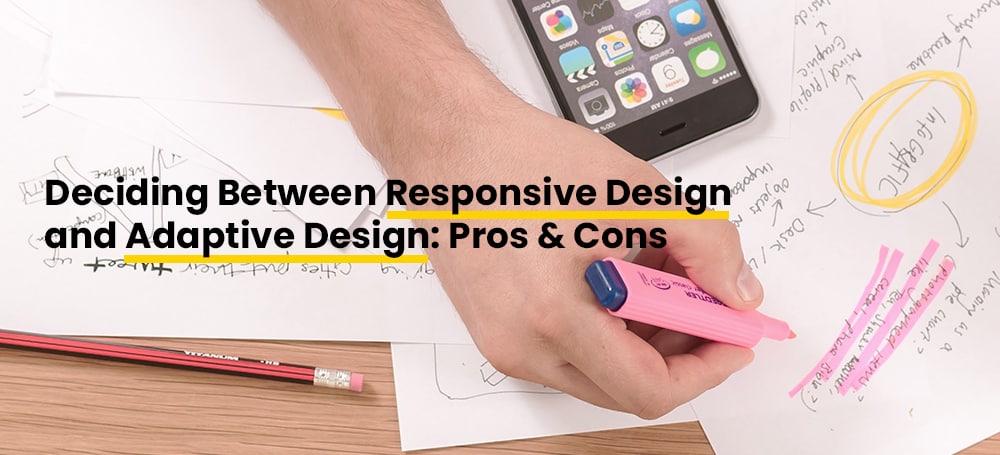

Deciding Between Responsive Design and Adaptive Design: Pros & Cons
Responsive design and adaptive design are two popular web design techniques that have emerged as valuable solutions for creating a user-friendly, interactive website experience for users.
In today’s competitive web design landscape, it can be hard to know which approach is best for your project. Both techniques have their own advantages and disadvantages and are often used in different types of web designs depending on the project goals. In this blog post, we’ll discuss the differences between responsive and adaptive design, go over the advantages and disadvantages of each approach, and provide tips to help you make an educated decision about which is the best option for your project. You’ll walk away with a better understanding of how each technique works, and you’ll be able to weigh the pros and cons to decide which one is the best fit for your needs.
1. Definition of responsive and adaptive design
Responsive design and adaptive design are two popular approaches to user experience on mobile devices. Responsive design is a single website that uses the same code base and the same URL, but adjusts its layout according to the size and orientation of the device used to view the website. Responsive design provides a consistent experience across all devices, but can be slow to load. Adaptive design, on the other hand, is the creation of multiple versions of a website tailored to specific device sizes and types. Adaptive design is faster to load on mobile devices, but can be more difficult to maintain since separate code bases must be maintained for each version of the website.
2. Pros and cons of each approach
When it comes to designing websites, there are two main approaches: responsive design and adaptive design. Both have advantages and disadvantages in terms of user experience and mobile responsiveness. Responsive design is based on a fluid grid and fluid images that scale to fit any device. This approach is great for users because it offers an optimal, consistent experience regardless of the device being used. However, it can be difficult to maintain and, if not done properly, can lead to slow loading times or difficulty accessing content. Adaptive design, on the other hand, is based on targeted layouts that are customized for different devices. This approach is great for mobile devices and offers speedy loading times and easy-to-navigate content. However, it can be difficult to maintain and offers a less flexible experience for users.
3. Considerations for budget
When it comes to budget considerations, it’s important to weigh the pros and cons of each type of design. Responsive design is generally less expensive than Adaptive design as there is less development involved. However, it may not provide the best user experience on mobile devices and tablets, depending on the complexity of the design. Adaptive design, on the other hand, is more expensive, but it can provide a superior user experience on mobile devices and tablets. Ultimately, it’s important to consider the budget and user experience when deciding between Responsive and Adaptive design.
4. Cost-benefit analysis
The fourth step for deciding between responsive and adaptive design is to conduct a cost-benefit analysis. It’s important to weigh the costs associated with each option against the benefits to determine which is most beneficial to the user experience. Responsive design is often the more cost-effective option, as it only requires the development of a single site. However, the cost of mobile responsiveness can be high if the project involves a complex, customized design. Adaptive design can be more expensive than responsive design, as it requires the design and development of separate sites for different device sizes. In the end, it’s important to decide which option will provide the best user experience for your target audience, and which is the most cost-effective in the long run.
5. Level of complexity
When considering whether to choose responsive or adaptive design, Level of complexity should be taken into account. While responsive design can be simpler to implement, Adaptive design can be more complex due to the need to develop and maintain multiple versions of the app. This can be especially true if the codebase needs to be changed often to accommodate different device types. However, this complexity can create a more customised and tailored mobile responsive user experience. Therefore, it is important to consider the pros and cons of each approach and decide which is better for your particular use case.
6. Pros and cons of using both approaches
When it comes to designing for the web, the debate between responsive and adaptive design can be a difficult one. On one hand, responsive design offers a single codebase for all devices, allowing for a consistent user experience across all platforms. On the other hand, adaptive design offers more control over the user experience, ensuring each device receives the best experience possible. When it comes to choosing between responsive and adaptive design, it’s important to consider the pros and cons of each approach. Responsive design allows for a single codebase, creating a unified user experience across all devices, while adaptive design provides more control over the user experience, allowing for more tailored experiences for each device. However, this comes at the cost of added complexity, as you need to manage multiple code bases. Ultimately, it is up to you to decide which approach best fits your needs.
7. Level of expertise needed for each approach
Both responsive design and adaptive design offer different levels of expertise needed to achieve the desired user experience. Responsive design is generally considered easier to implement with basic programming skills in HTML, CSS, and JavaScript. On the other hand, adaptive design requires more expertise in server-side programming such as PHP and ASP.NET. Thus, the level of expertise required to implement either responsive or adaptive design depends on the complexity of the website and the nature of the design elements that need to be implemented.
8. Potential for scalability with each approach
When considering whether to choose between Responsive and Adaptive Design, it’s important to evaluate the potential for scalability with each approach. Responsive design provides a uniform user experience across all devices, making it easier to scale across multiple devices and platforms. On the other hand, Adaptive Design offers more flexibility and control, allowing for a more tailored user experience, however, this may require additional resources to ensure consistent performance. Ultimately, it’s important to consider how each approach meets the needs of your users and how scalable each design is for future development.
In conclusion, when deciding between responsive and adaptive design, it is important to consider the needs of your website and the resources you have available. Responsive design provides a great user experience across multiple devices, and adaptive design can be more cost-effective and provide greater control. Ultimately, the best choice depends on your individual website needs and preferences.
We, at Roars Technologies, are dedicated to providing exceptional user experience design who want to make a difference in their industry and connect to their customers in a better way. Let’s talk and find out how we can build you a phenomenal User experience app.

